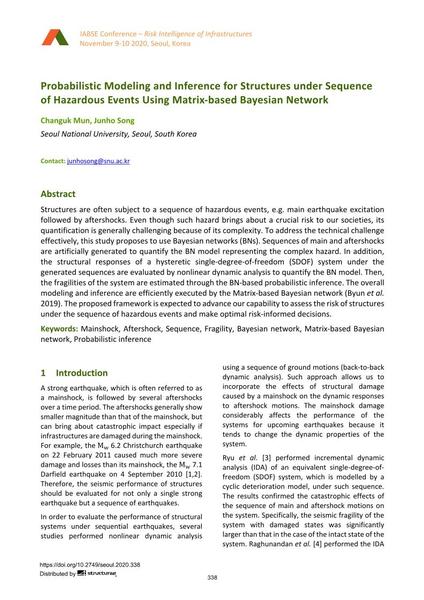Probabilistic Modeling and Inference for Structures under Sequence of Hazardous Events Using Matrix-based Bayesian Network

|
|
|||||||||||
Bibliographic Details
| Author(s): |
Changuk Mun
(Seoul National University, Seoul, South Korea)
Junho Song (Seoul National University, Seoul, South Korea) |
||||
|---|---|---|---|---|---|
| Medium: | conference paper | ||||
| Language(s): | English | ||||
| Conference: | IABSE Conference: Risk Intelligence of Infrastructures, Seoul, South Korea, 9-10 November 2020 | ||||
| Published in: | IABSE Conference Seoul 2020 | ||||
|
|||||
| Page(s): | 338-345 | ||||
| Total no. of pages: | 8 | ||||
| DOI: | 10.2749/seoul.2020.338 | ||||
| Abstract: |
Structures are often subject to a sequence of hazardous events, e.g. main earthquake excitation followed by aftershocks. Even though such hazard brings about a crucial risk to our societies, its quantification is generally challenging because of its complexity. To address the technical challenge effectively, this study proposes to use Bayesian networks (BNs). Sequences of main and aftershocks are artificially generated to quantify the BN model representing the complex hazard. In addition, the structural responses of a hysteretic single-degree-of-freedom (SDOF) system under the generated sequences are evaluated by nonlinear dynamic analysis to quantify the BN model. Then, the fragilities of the system are estimated through the BN-based probabilistic inference. The overall modeling and inference are efficiently executed by the Matrix-based Bayesian network (Byunet al.2019). The proposed framework is expected to advance our capability to assess the risk of structures under the sequence of hazardous events and make optimal risk-informed decisions. |
||||
| Keywords: |
fragility Mainshock aftershock Sequence Bayesian network Matrix-based Bayesian network Probabilistic inference
|
||||
